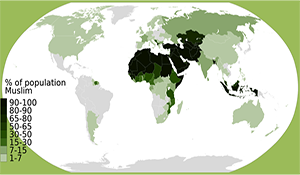
Post-ISIL Iraq Scenarios
Question (V4): Post-ISIL Iraq Scenarios. What are the most likely post-lSIL Iraq scenarios with regards to Political, Military, Economic, Social, Information, Infrastructure, Physical Environment, and Time (PMESII-PT)? Where are the main PMESII-PT friction points, which are most acute, and how are they best exploited to accomplish a stable end state favorable to U.S. and coalition […]
Continue Reading
Influence Future of Syria
Question (V5): Factors that Will Influence the Future of Syria. What are the factors that will influence the future of Syria and how can we best affect them? Author | Editor: Astorino-Coutois, A. (NSI, Inc). Experts varied from pessimistic (chronic warfare) to cautiously optimistic regarding their expectations for the future of Syria, yet mentioned many […]
Continue Reading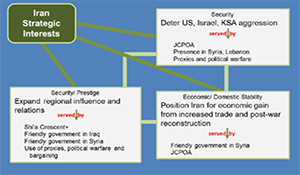
Iran Nuclear Deal Implications
Question (V6): Strategic and Operational Implications of the Iran Nuclear Deal. What are the strategic and operational implications of the Iran nuclear deal on the US-led coalition¹s ability to prosecute the war against ISIL in Iraq and Syria and to create the conditions for political, humanitarian and security sector stability? Author | Editor: Astorino-Coutois, A. […]
Continue Reading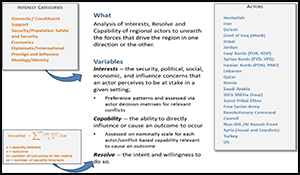
Countering the ISIL Fight
Question (V7): Objectives and Motivations of Indigenous State and Non-State Partners In the Counter-Isil Fight. What are the strategic objectives and motivations of indigenous state and non-state partners in the counter-ISIL fight? Author | Editor: Astorino-Coutois, A. (NSI, Inc). The following are high-level results of a study assessing Middle East regional dynamics based on the […]
Continue Reading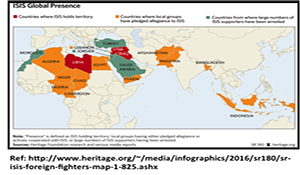
Info OPs in Iraq and Syria
Question (S3): What must the coalition do in the information environment to achieve its objectives in Iraq and Syria and how can it deny adversaries the ability to achieve theirs? Author | Editor: Spitaletta, J. (Johns Hopkins University Applied Physics Laboratory). The following set of responses to Question S3 represent an attempt to distill the […]
Continue Reading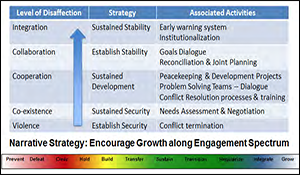
Socio-Political Stability in Syria and Iraq
Options to Facilitate Socio-Political Stability in Syria and Iraq. Author | Editor: Astorino-Coutois, A. (NSI, Inc) & Cabayan, H. (Joint Staff). This White Paper presents the analytic results from Strategic Multi-layer Assessment (SMA) project touching on the Middle East and North Africa. The objective is to suggest options to manage conflict in the region and […]
Continue Reading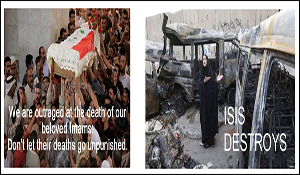
Counter-Da’esh Influence Operations
Counter-Da’esh Influence Operations: Cognitive Space Narrative Simulation Insights. Author | Editor: Linera, R. LTC, Seese, G. MAJ (USASOC) & Canna, S (NSI, Inc). At the request of Joint Staff/J-39, the SMA program, in coordination with United States Army Special Operations Command (USASOC) and the Department of Homeland Security (DHS), participated in a second Counter-Da’esh Messaging […]
Continue Reading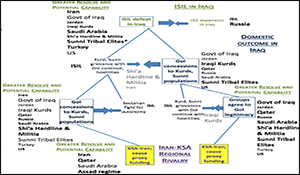
Part IV: Results of 5 of 8 Conflicts in Iraqi-Syria
Part IV: Analysis of the Dynamics of Near East Futures: Assessing Actor Interests, Resolve and Capability in 5 of the 8 Regional Conflicts. Author | Editor: Astorino-Coutois, A. (NSI, Inc). This briefing is the final part of a four-part study exploring the dynamics of the central Middle East conflict system. Part II describes the system […]
Continue Reading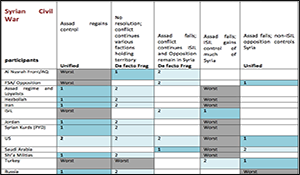
Part III: Use Case Analysis of Iraqi-Syrian Conflict
Unpacking the Regional Conflict System surrounding Iraq and Syria—Part III: Implications for the Regional Future: Syria Example of Actor Interests, Resolve and Capabilities Analysis. Author | Editor: Astorino-Coutois, A. (NSI, Inc). This is Part III of a larger study exploring the dynamics of the central Middle East conflict system. Part I described the system and […]
Continue Reading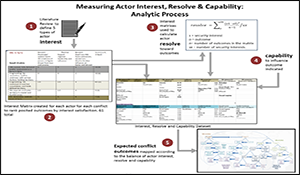
Part II: Assessing Dynamics of the Iraqi-Syrian Conflict
Unpacking the Regional Conflict System surrounding Iraq and Syria—Part II: Method for Assessing the Dynamics of the Conflict System, or, There are no sides—only interests. Author | Editor: Astorino-Coutois, A. (NSI, Inc). This is Part II of a larger study exploring the dynamics of the central Middle East conflict system. Part I described the system […]
Continue Reading